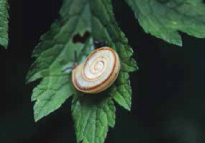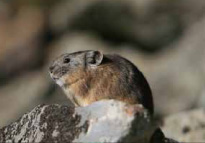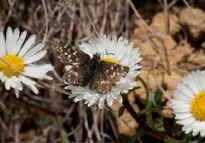4. The precious plants and animals surrounding Mt. Apoi
- Theme B:
Learning about and enjoying the natural environment from Mt. Apoi's alpine plants
Apoimaimai (Paraegista apoiensis) - Evolution into an endemic species under the influence of rock

The unique components of peridotite are considered to affect the evolution of plants and animals alike. Apoimaimai (Paraegista apoiensis, registered as a new species in 1970) is a snail endemic to the Apoi Mountains, its surroundings and the area along the Horoman River. The species is closely related to Takahidemaimai (Paraegista takahidei) of the Himemaimai (Ainohelix editha) genus that inhabits Hokkaido, and lives in crevices between peridotite rocks and elsewhere. The brown shell of an adult snail measures approximately 1 cm and has thin stiff hairs on its surface.
Kadobarihimemaimai (Ainohelix editha var.) - Distribution closely related to certain rocks

Kadobarihimemaimai (Ainohelix editha var.) is a rare snail found only in certain areas, including Mt. Obira in Shimamaki Village and Samani Town. Its characteristic shell looks like a noodle bowl with a flat lid featuring a clear spiral pattern.
Kadobarihimemaimai is found only in limestone areas, but not just any limestone area; it may be found along a particular stream but not in the same area along a different one. As its rarity makes it particularly sought after by collectors, appropriate protection measures are needed to prevent its extinction.
Japanese pika (Ochotona hyperborea yesoensis) - Relics of the Ice Age

Hokkaido is Japan's only habitat for Japanese pika, and their distribution is mostly limited to mountainside areas in the alpine zone of the Kitami, Taisetsu, Yubari and Hidaka mountains. It inhabits the rocky terrain usually found at high altitudes, but on Mt. Apoi it has been found on lowlands at just 50 meters above sea level - Hokkaido's lowest-altitude habitat for the species.
Himechamadaraseseri (Pyrgus malvae) - Found only on Mt. Apoi in Japan and designated as a Natural Monument of Japan in 1975

Mt. Apoi and its surroundings represent Japan's only habitat for Himechamadaraseseri (of the family Hesperiidae), although the species is found widely on the Korean Peninsula and in Europe. It was discovered by students of the Hokkaido University Insect Research Group in 1973, and was designated as a Natural Monument of Japan in 1975 . Its adult butterflies are seen only for a short time around May. They feed on the nectar of Apoiazumagiku (Erigeron thunbergii var. angustifolius) and other flowers, but on Kinrobai (Potentilla fruticosa var. rigida) in their larval stage.
Kitagoyo (Pinus parviflora var. pentaphylla) - Northern limit of its habitat and the Japanese white pine habitat in Horoman (designated as a Natural Monument of Japan in 1943)
Like dwarf stone pines, Kitagoyo is a species of the Japanese white pine, which is also known as the five-leaved pine because it has five needle leaves per fascicle. Kitagoyo is found in areas from central Honshu up to southern Hokkaido, but generally grows in small communities on mountain ridges due to weak interspecific competition. Meanwhile, the habitat of Kitagoyo trees at the foot of Mt. Horoman is known as the northern limit of the species' habitat and dominates the slopes there, leading to the area's designation as a Natural Monument of Japan.


Dwarf stone pine needle leaves and seed

Kitagoyo needle leaves and seed (with wings)



